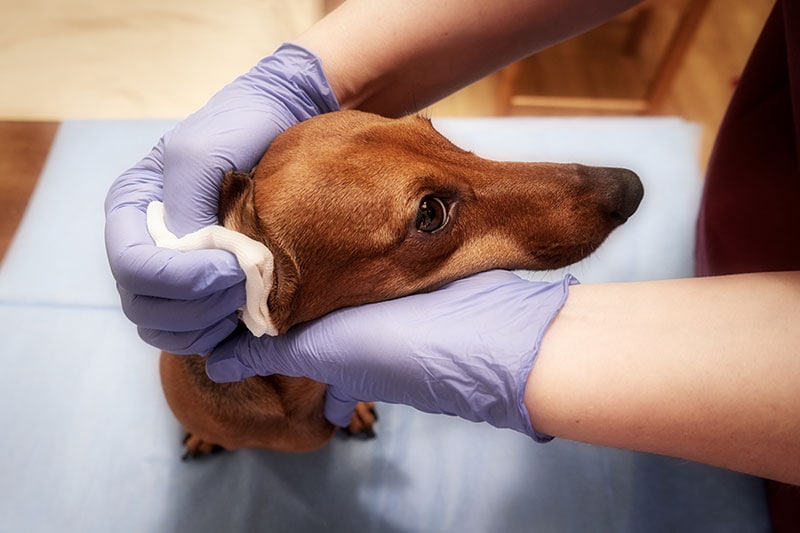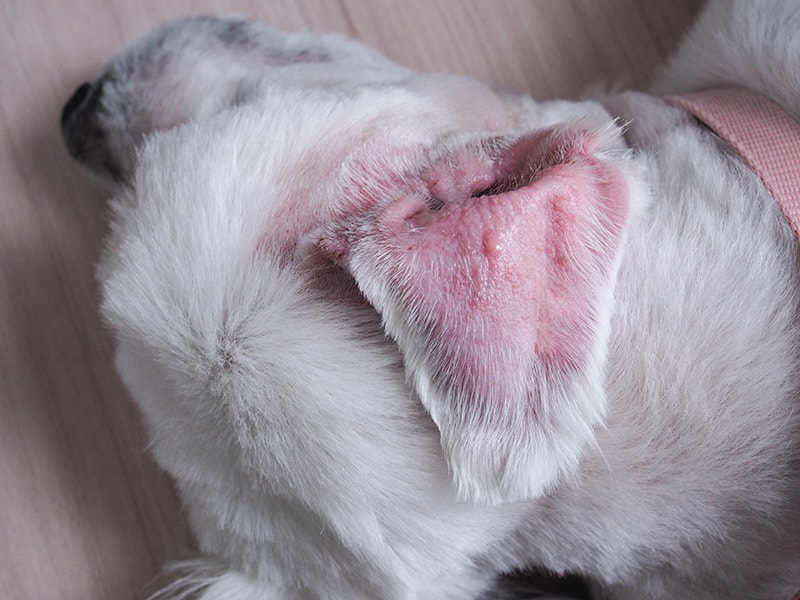In this article
View 7 More +Dogs with one ear up and one ear down are undeniably adorable, but as it turns out, this isn’t always a good thing to see. In a dog that usually has two up ears, this may be a sign of an ear hematoma that needs treatment.
It is sometimes harder to notice quickly in a dog with down ears. This phenomenon can be a recurrent issue in some dogs. So, here’s what you need to know about what it is, why it happens, and what to do about it.

What Is an Ear Hematoma?
Also known as an aural hematoma, an ear hematoma is a pooling of blood in the ear pinna. The flap of an ear, the external part, is also known as the pinna. You want to think of that flap as two layers of skin, one for the outer aspect of the pinna, one for the inner, that are fused with little more than some ear cartilage in between.
An ear hematoma is when blood pools between those two layers, creating a fluid-filled space that wasn’t there before. This can happen for a few reasons, but depending on how big the hematoma is, this extra weight is what will flop down an up ear and leave the ear uncomfortable regardless of which position it started in.

What Are the Signs of an Ear Hematoma in Dogs?
An ear hematoma will look like a bubbled or swollen area of the ear pinna. Sometimes the whole ear pinna is swollen. Sometimes it’s just a small portion. When you squeeze it, the area should feel fluid-filled, almost like a water balloon.
Ear hematomas are uncomfortable, sometimes outright painful. Touching the area may cause a dog to pull away or cry out. Even when you don’t touch it, your dog will likely be shaking their head or scratching at the area because of how it feels.
Depending on the cause of the ear hematoma, you may also note scratches on the ear or blood, discharge or debris from the ear canal, an odor from the ear, foot licking/chewing, generalized itchiness, red eyes or eye discharge, decreased appetite, or general restlessness.
Ear hematomas are usually present in one ear at a time but can occur in both.
What Causes Ear Hematomas in Dogs?
Ear hematomas form when the cartilage inside the ear cracks or blood vessels break inside the ear, causing bleeding inside the layer of tissue in the ear pinna.
This is most commonly caused by head shaking. Some dogs will be more prone to this than others, with some needing to shake excessively for prolonged periods to form a hematoma, while others seem to get it when you’ve barely seen any shaking at all. There is a possible autoimmune component to this or a connection with other diseases a dog may have, such as Cushing’s, which can leave them with fragile blood vessels.
In most cases, dogs will have an underlying ear infection, which leads to scratching or shaking, which causes the trauma that leads to the ear hematoma. Other possible causes for head shaking or ear scratching include allergies or mites.
The most common cause of repeat ear infections in dogs is underlying allergies, so in a lot of cases, the cause of an ear hematoma is really allergies, which causes an ear infection, which causes a hematoma when the dog scratches or shakes.

How Are Ear Hematomas Diagnosed in Dogs?
A physical exam by a veterinarian will allow them to diagnose an ear hematoma. They have a recognizable look and feel that isn’t very similar to other issues, though cysts, tumors, and abscesses may need to also be ruled out.
A dog diagnosed with an ear hematoma will also need an ear cytology. Ear cytologies involve taking a swab from each ear and applying that swab sample to a slide to be examined under a microscope. This lets the doctor screen for bacterial or yeast infections of the ear canal that can cause a hematoma, along with ear mites.
A discussion about allergies and a possible allergy diagnosis would also be common for ear hematoma dogs.

How Are Ear Hematomas in Dogs Treated?
There are an infinite number of ways to treat an ear hematoma in dogs, but treatment mostly falls into two categories: medical or surgical.
Medical Treatment
Steroids have been shown to improve the resolution of ear hematomas significantly. This can be accomplished in several ways. Generally, the ear hematoma would be drained by inserting a needle into the affected area of the ear pinna. This can then be followed by injecting steroids into that pocket afterward. Variations of this can include injecting steroids without draining, giving oral steroids, doing both, or giving oral steroids without draining the hematoma.
Ear infections that are also present would be treated, as would underlying allergies or mite infections when present. The dog will need to be placed in an E-collar for the duration of treatment, usually two to three weeks, to prevent scratching, and a bandage or head wrap usually needs to be applied to prevent trauma from shaking and to catch drainage.
Surgical Treatment
Depending on the severity or if this is a recurring hematoma, surgical treatment may be preferred. In this case, under heavy sedation or anesthesia, the hematoma is laced with varying incisions (techniques differ), and the two sides of the ear are sewn together to prevent the pocket from refilling, or a drain or cannula of some type is inserted to allow fluid to continue to drain out instead of accumulating.
Ear hematomas can also be allowed to heal on their own. The problem is that while a clot will form, the body will resorb the clot/fluid, and fibrosis will develop; this leaves scarring of the ear that causes permanent deformation of the pinna, known as a cauliflower ear. The changed ear pinna structure itself isn’t painful, but this can take weeks to months to resolve on its own, leaving the dog uncomfortable until that happens, these changes can sometimes affect the ear canal also, which can predispose the dog to ear infections in the future.
Dogs that don’t undergo treatment for the underlying problem—be it infection, allergies, or mites—may not resolve even with hematoma treatment. Hematomas can go down while stitches are in place and the dog is on medication, but upon stopping treatment, they may fill back up. It isn’t uncommon to start with medical treatment, and if the hematoma recurs, try surgery, and if it’s still recurring, combine multiple surgical techniques to keep them from refilling.


How Do I Care for a Dog With an Ear Hematoma?
Dogs with an ear hematoma will most likely be sent home with medication. They may need topical ear medication applied daily, and they may have oral medications also. Dogs getting medical treatment will likely have oral steroids to take, while dogs getting surgical treatment may have NSAIDs (anti-inflammatory pain medication) and possible antibiotics. It is critical to know that a dog CANNOT take both NSAIDs and steroids at the same time, so do not confuse these or start giving them from a leftover supply at home without consulting a veterinarian first.
Additionally, many dogs will have their ear wrapped to their head, whether the hematoma was incised or not. This is because they will still likely shake their head for a period, and this protects the ear from further trauma during this time. While this may be wrapped with bandages at the clinic, another useful headwrap you may be sent home with or may want to purchase yourself is the No Flap Ear Wrap.
Some doctors may ask you to handle a dog’s hematoma ear daily to push any newly accumulating fluid through a drain or incision for better and faster healing. You should be provided with clean-up materials for this process in those cases, but you’ll want to be sure to do this on the schedule the veterinarian prescribed for best success.
If you’re concerned about your dog’s health we suggest you speak to a vet.
If you need to speak with a vet but can't get to one, head over to PangoVet. It's our online service where you can talk to a vet online and get the advice you need for your dog — all at an affordable price!
Can Ear Hematomas in Dogs Be Prevented?
Since most ear hematomas are caused by ear infections and allergies, prompt treatment of these conditions is the best way to prevent ear hematomas. Be sure to clean your dog’s ears after baths and swimming sessions, and do not let allergy treatment lapse for allergy dogs.
If you notice your dog shaking their head, check for signs of infection in the ear, such as odor, debris, or discharge, and signs of allergies, such as foot licking, red eyes with possible discharge, and scratching.
If you notice head shaking from your dog, check in with your veterinarian so they can get to the bottom of the problem, hopefully before an ear hematoma forms.


Frequently Asked Questions (FAQs)
Is a dog’s ear hematoma serious?
While this isn’t a life-threatening condition, it is often painful and resolves best with prompt treatment. If a hematoma is present for longer than 7 days, it makes it much less likely that it can heal without significant scarring, so you’ll want to see a vet as soon as you notice an ear hematoma.
What do I do if my dog’s ear hematoma bursts on its own?
It is likely that significant fluid or blood will come out of the ear when this happens. You’ll want to clean everything thoroughly with just soap and water, try to push out any remaining fluid in the ear through the new hole, wrap the ear, if possible, then get them the next available vet appointment for further treatment. Ear hematomas that drain but don’t receive any other treatment will almost certainly refill, so you’ll still want to get this treated.
How urgent is a dog’s ear hematoma?
While this doesn’t necessitate an emergency visit, you still want to have an ear hematoma examined by a veterinarian as soon as you can, as the earlier it is treated, the smoother resolution usually goes and the less likely it is that there will be permanent scarring.

Can I drain my dog’s ear hematoma at home?
This isn’t recommended because, in most cases, the hematoma will just fill back up afterward. You are also unlikely to have a safe instrument to drain the ear with at home that doesn’t risk infection or unnecessary trauma.
Should I massage my dog’s ear hematoma?
Massaging a swollen ear hematoma can be painful and isn’t usually a good idea. Some doctors may include massaging the area as part of the treatment plan after draining the hematoma. Other alternative treatment ideas can include cold laser therapy of the ear to lower inflammation, though this is usually done at a veterinary clinic.

Conclusion
Although painful and unsightly, ear hematomas can resolve with little to no long-term consequences in most cases if treated within a day or so of appearing. Since most ear hematomas have an underlying cause, such as an ear infection or allergies, treatment of ear hematomas includes screening for and treating the underlying problem.
While ear hematomas can technically be drained from home, this will rarely treat the hematoma, and it is safest and most effective to bring them into the veterinary clinic for diagnosis and treatment when you notice one. If you notice your dog has a swollen ear flap, be sure to get your pup an appointment as soon as you can.
Featured Image Credit: Kittima05, Shutterstock



















